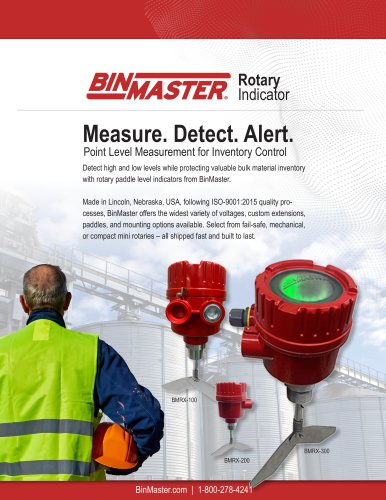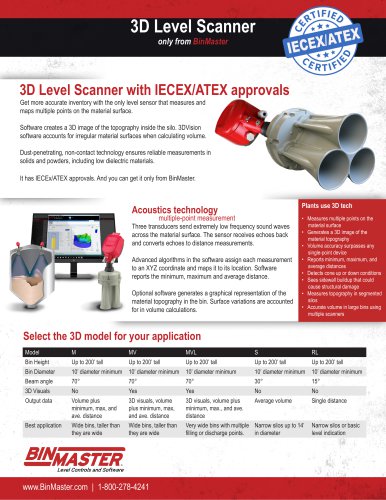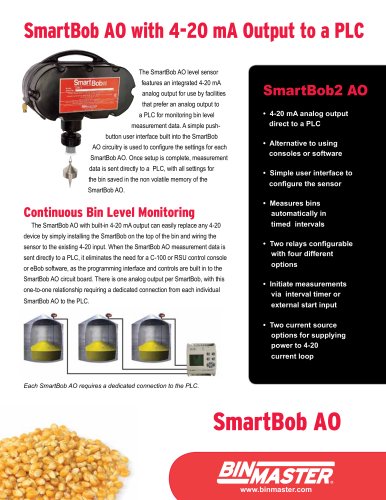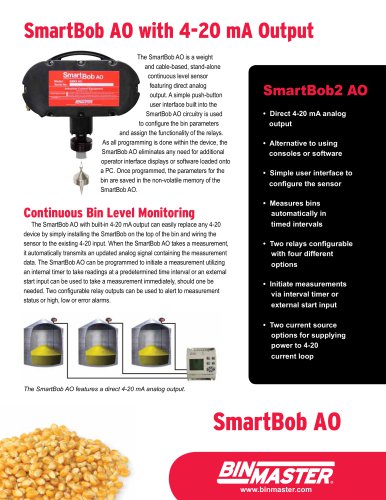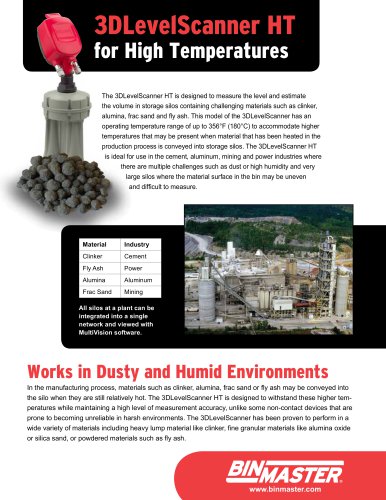 Website:
BinMaster
Website:
BinMaster
Catalog excerpts
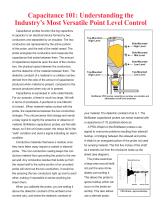
PRO-Shield—Ignores Buildup Capacitance probes function like big capacitors. A capacitor is an electrical device formed by two conductors and separated by an insulator. The two conductors are represented by the active portion of the probe, and the wall of the metal vessel. The probe energizes the conductors and measures the capacitance that exists between them. The amount of capacitance depends upon the size of the conductors, the physical space between the conductors, and the dielectric of the material between them. The dielectric constant of a material is a unitless number, derived from the ratio of the amount of capacitance produced when material is present, compared to the amount produced when only air is present. Capacitance is expressed in units called farads. For our purpose, a farad is much too large. We talk in terms of picofarads. A picofarad is one-trillionth of a farad. When material makes contact with the probe, the capacitance between the two conductors changes. The unit perceives that change and sends a relay signal to signify the presence or absence of material. BinMaster capacitance probes use fail-safe relays; so if the unit loses power, the relays fall to the "safe” condition and send a signal indicating an alarm condition. Conductive materials that leave a residue once they have fallen away require a coated or sleeved probe. This non-conductive coating keeps the conductive material from grounding the probe to the vessel wall. Any conductive residue that builds up from the vessel wall to the active portion of an uncoated probe will short out the two conductors. It would be like pressing the two conductors right up next to each other, making it impossible to sense anything between them. When you calibrate the probe, you are setting it above the dielectric constant of the ambient environment (air), and below the dielectric constant of your material. The dielectric constant of air is 1. The BinMaster capacitance probes can sense material with a capacitance of 1/2 picofarad above air. A PRO-Shield on the BinMaster probes is designed to overcome problems resulting from sidewall buildup, or bridging between the sidewall and probe. A shield is an energized portion of the probe not used for sensing material. The first five inches of the shaft as it extends out from the enclosure make up the shield (see diagram). The probe examines a large area around itself, not just the area immediately surrounding it. This allows the probe to ignore buildup which can occur on the probe assembly. This also allows use a sleeved probe.
Open the catalog to page 1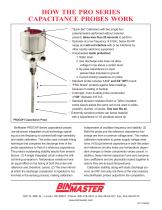
HOW THE PRO SERIES CAPACITANCE PROBES WORK PROCAP I Capacitance Probe √ “Quick Set” Calibration with two single-turn potentiometers performed without material present, takes less than 20 seconds to perform. √ Operates at a low frequency of 6 KHz, below the RF range and will not interfere with or be interfered by other nearby electronic equipment. √ Unsurpassed static protection: 1. Static drain. 2. Gas discharge tube does not allow voltage to rise above a certain level. 3. By-pass capacitance on input passes false impulses to ground. 4. Current limiting resistance on probe √ Standard probe...
Open the catalog to page 2All BinMaster catalogs and technical brochures
-
FeedView brochure
4 Pages
-
CNCR-400 Brochure
2 Pages
-
BMRX-300 Brochure
4 Pages
-
Full Line Brochure
24 Pages
-
NCR-86 Full Line Brochure
8 Pages
-
SmartSonic Brochure
8 Pages
-
Mini Rotary Brochure
2 Pages
-
3D Angled Mounting Flange
1 Pages
-
DPM-100 Display Brochure
2 Pages
-
DPM-200 Display Brochure
2 Pages
-
FVL-200 Brochure
4 Pages
-
SPL-200 Brochure
4 Pages
-
Tilt Switch Brochure
2 Pages
-
C-100 Display Brochure
2 Pages
-
Capacitance Probe Brochure
12 Pages
-
BMRX-200 Brochure
2 Pages
-
BMRX-100 Basic Rotary
2 Pages
-
GWR-3000 brochure
2 Pages
-
Vibrating Rod - 90
2 Pages
-
Vibrating Fork brochure
2 Pages
-
Airbrator
2 Pages
-
Vibrating Rod 90
2 Pages
-
Rotary Product Line Brochure
8 Pages
-
ProCap HD Brochure
1 Pages
-
BinMaster DPM-300
8 Pages
-
Flow Detect 2000
2 Pages
-
GWR-2000 Guided Wave Radar
4 Pages
-
Adjustable Rotary
1 Pages
-
MultiBob System Brochure
8 Pages
-
CVR-600 Mini Vibrating Rod
2 Pages
Archived catalogs
-
Full Line Product Catalog
24 Pages
-
CNCR Non-Contact Radar
12 Pages
-
3DLevelScanner
8 Pages
-
Full Line Catalog
24 Pages
-
Airpad
2 Pages
-
Vibrating Fork 95
2 Pages
-
NCR-84
4 Pages
-
NCR-25 & NCR-30 Brochure
4 Pages
-
Diffuser Air Pad Brochure
2 Pages
-
DPM-200 Digital Panel Meter
6 Pages
-
SmartBobII MUCM Brochure
2 Pages
-
NCR-80 Accessories Brochure
3 Pages
-
Mini Vibrating Rod
2 Pages
-
Digital Panel Meter Display
8 Pages
-
BinMaster DPM-200
6 Pages
-
BinMaster Rotary brochure
8 Pages
-
Get the Point
7 Pages
-
MND Modbus Network Display
3 Pages
-
DPM-100
8 Pages
-
Binventory Software Brochure
4 Pages
-
VR-0515-NPC
4 Pages
-
NCR-80 Options Brochure
3 Pages
-
NCR-80 Non-Contact Radar
4 Pages
-
3D Angled Mounting Adaptor
2 Pages
-
3D 0 Degree Mounting Flange
1 Pages
-
Mercury_Free Tilt Switch
2 Pages
-
Mini-Rotary Brochure
2 Pages
-
SmartBob2 MUCM Brochure
2 Pages
-
Dust Detect 1000 Brochure
2 Pages
-
Diaphragm Switch Brochure
2 Pages
-
COMPACTPRO Brochure
2 Pages
-
3D Technical Data Brochure
4 Pages
-
WT 19
3 Pages
-
WL 19
3 Pages
-
BinMaster Rotary Brochure
8 Pages
-
3D MultiVision Software
4 Pages
-
BinMaster Air Pad Brochure
2 Pages







